|

| Introductory videos
Grandmaster Karsten Müller from Hamburg sets the mood for you in his video introduction to this issue. As well as some pearls from the top tournaments, he draws to your attention in openings articles on the Scandinavian with ...Qa5 and ...Bg4 (by GM Christian Bauer), the Sicilian with 4...d5 (GM Dejan Bojkov) and the Ruy Lopez Steinitz Variation with, e.g.g, 5.c3 f5 (GM Leonid Kritz) to three aggressive repertoire suggestions for Black. And as an appetiser to Oliver Reeh’s tactics column, Müller demonstrates a fantastic combination from the Women’s WCh. |
 | GM Dorian Rogozenco reviews the tournament highlights of the last two months on video. In the case of the London Chess Classic he concentrates above all on the performance of the surprisingly strong English player Luke McShane, who was not only able to defeat Magnus Carlsen but who also went through the whole tournament undefeated. As far as the top tournament in Reggio Emilia is concerned, Rogozenco explains Gashimov’s coup in his game against Vallejo Pons who had made such a fast and furious start – an absolute must for all friends of the Pirc Defence! To close this first video review the Romanian GM summarises for you events in the Russian Superfinal. |
 | In his second videoRogozenco concentrates totally on the Women’s World Championship in Antakya in Turkey. He uses selected games and game fragments to sketch in the route to the final taken by the two Chinese players, Hou Yifan and Ruan Lufei. In particular in her semi-final game against the Indian co-favourite Humpy Koneru, the new world champion treated us to some first class chess. Rogozenco also points out with reference to analyses by GM Evgeny Postny how in the second game in the final Ruan Lufei could have found a tricky way to a draw in the rook ending. |
| 28.12.2010-06.01.2011 
Victor on tie-break
Vugar Gashimov
| Reggio Emilia 2010/11 Exactly 20 years ago in Reggio Emilia the greatest members of their guild - Kasparov, Karpov and the young Anand – fought it out for victory. In the 53rd running of the traditional tournament this year, there were perhaps not the absolutely top names, but players of the calibre of Ivanchuk, Gashimov, Morozevich, Caruana, Short, etc. meant that the list of participants was a distinguished one. But at the start the pace was set by the top Spanish player Francisco Vallejo Pons. No one could match his lightning start of 3.5 of 4. However, in the long run it would only be sufficient for a shared first place. You will find on the DVD a detailed tournament report as well as games analysed by joint winners Gashimov and Vallejo Pons and also Caruana. |

Vallejo Pons,F - Gashimov,V
Position before 11...Ng4
| In the important duel between Vallejo Pons and Gashimov in round 7, the Azerbaijani deliberately aimed at unusual types of position with his first move 1...g6. In his analysis on the DVD Vugar Gashimov takes the point of view that his opponent went wrong early on with 8.Bf4. In the position on the board (the previous move had been 11.Bf4-e3) Gashimov continued with the surprising knight sortie 11...Ng4 and after the exchanges he immediately had the better game. In the middlegame he gave up his pawn on e5 for the white a-pawn and after the exchange of queens he already had what was essentially a winning position. As Gashimov, however, points out critically in his analysis, he missed the chance to get his candidate for a queen on the a-file going in good time. Thus the belated advance should have found itself biting on granite after the defensive move 46.Nb2. But the Spaniard went wrong and allowed his opponent to liquidate to a winning rook or pawn ending. |

Vallejo Pons,F - Onischuk,A
Position after 22.Qf5
| After this defeat Vallejo Pons shared the lead with Gashimov. In his next game against Onischuk the Spanish player once more put his faith in 1.e4 and turned once more for the first time after a long period to the Scotch. In his preparation for the variation with 4...Nf6 5.Nc6 bxc6 6.e5 Qe7 7.Qe2 Nd5 Vallejo had looked out for a surprise 8.Nd2. But as he admits in his analysis, he was forced to realise there had been a hole in his preparation after 8...Bb7, and Onischuk could have steered the game into calmer waters with an early exchange of queens. Instead, Vallejo Pons managed, despite the reduced material, to work up significant pressure within a few moves and in the position on the board 22.Qf5 was followed by 22...Rde8 23.Rf3 and 23...Qxh4 was the all-important and decisive error by the American. Play through the game with the comments by Vallejo Pons and enjoy his attack on the king, including its queen sacrifice. |

Caruana,F - Short,N
Position after 33...bxc3
| Italian chess fans had certainly been hoping for a victory for their top player Fabiano Caruana. But as early as round 2 he was forced to admit defeat at the hands of David Navarra. Caruana finished in the middle of the field with 50%. He analyses in depth on the DVD his victory over Nigel Short. In the Tarrasch Variation of the French Defence the English player confronted him after 5.exd5 exd5 6.Bb5 with the rare move 6...exd4. Caruana’s reply 7.0-0 did not turn out to be very ambitious and there followed at first some skirmishes for the initiative and for better play with the pieces. The balance was disturbed by a serious error on the part of Short (29...Qg3), which led to the loss of his d-pawn. But Caruana’s reaction was not error-free either. In the position in the diagram, instead of 34.bxc3 the exchange on f7 would have led after 35.Qc4+ Kf8 36.Qf1+ Kg8 37.Re7 Rf8 38.Qc4+ to mate. So Caruana still had to prove his skill in a queen ending. |
| 04.12.-24.12.2010 
The youngest World Champion
Hou Yifan
| Women's WCh Antakya The Women’s world championship was held over almost three weeks in the city of Antakya in the south of Turkey. For those players who had advanced so far in the tournament this meant an enormous distance and a battle of the nerves. Because up to the final the tournament rules meant a k.o. mode in two-game matches. One of the Elo favourites and at the same time one of the youngest players in the field, Hou Yifan from China, made all the running. At the age of 16 Jahren she even outdid the performance of Maia Chiburdanidze, who previously (1978) became world champion at 17. Hou Yifan is, in the footsteps of Xie Jun (1991-1996 and 1999-2001), Zhu Chen (2001-2003) and Xu Yuhua (2006-2008) already the fourth Chinese women’s world champion. |

Hou,Y - Koneru,H
Position before 74.h5
| On the way to the final Hou Yifan first eliminated Kateryna Lahno and Zhu Chen. What was on paper her strongest challenge came in the semi-final: in the WCh of 2008 there had been a hard struggle going into a tie-break with the strongest Elo rated player Humpy Koneru. This time Hou Yifan was able to impose herself over the short distance and made the most of her win with White in the first game. The new world champion annotates this game for you on the DVD. The Indian player had prepared the Berlin Defence for her duel with Hou Yifan. The Chinese player chose in 10.Ne2 a side line and maintained the advantage of the superior pawn structure right into the endgame with two rooks and a bishop on either side. With great skill and a little help from her opponent she liquidated successfully into a winning but technically demanding bishop ending, which Hou Yifan annotates in detail on the DVD. The position on the board shows the decisive moment: after 74.h5 gxh5 75.f5 gxf5 76.e6 one of the two pawns will make it through. |

Ruan,L - Hou,Y
Position before 21.Bxd5
| The Chinese player was never in any serious danger in the second game and thus comfortably reached the final. And for the first time in the history of chess this was a purely Chinese affair. Hou Yifan was faced by the 23 year old and as yet little known Ruan Lufei. After a hard-fought draw in the first game of the final, Hou Yifan scorded the first win in the second game with Black. GM Evgeny Postny has analysed this game thoroughly on the DVD. Ruan Lufei treated the Scheveningen Variation very subtly and came out of the opening with an advantage, but in the position in the diagram she gave away all her chances with the text move 21.Bxd5. According to Postny’s analysis, after 21.Bd4 c5 22.Bxd5 cxd4 23.Bxe6 fxe6 24.Qe5 Rxc2 25.Qxe6+ winning the pawn on d4 she would have obtained a clear advantage. In the game Hou Yifan got the upper hand after the exchange of queens and after two mistakes by her opponent she liquidated to a clearly won rook ending. |

Silver after tie-break
Ruan Lufei
| But Ruan Lufei was still in the match. In the third game (another Caro-Kann) she successfully managed to avoid defeat after a hard struggle. And in the final game played with the longer thinking time, she even managed to equalise the match at 2:2. In the Scheveningen Variation Hou Yifan went in for an exotic queen sortie with 12...Qh2 and this was then countered in ice-cold fashion by her opponent. GM Mihail Marin also takes a look at this game in his openings report.
This surprising 2:2 draw meant that the decision was put off to a rapid chess match of four games. Here too, after an opening draw Hou Yifan went into the lead with a victory and after another draw Ruan Lufei would have needed to win the final game with Black. But this was just one step too far for her. Hou Yifan held her nerve and secured the title with another win. This fourth game of the play-off has also been annotated by Hou Yifan on the DVD. Click on the link Hou,Y - Ruan,L and play through the game with the comments of the World Champion. |

Openings survey
Mihail Marin
| Do women actually play different openings from men? Were there in the Women’s WCh new ideas in the opening which, as can be the case with the top men players, have the potential to set new trends? GM Mihail Marin devotes his openings survey of this issue to the games played by the top women and summarises his conclusions for you in a detailed text report with analysis and links to the annotated games. In Antakya 1.e4 was the most frequently chosen opening move, and the most important topic was the various variations of the Sicilian Defence. Marin indicates, for example, that the English Attack was not used in a single game. For the Classical French with 3.Nc3 Nf6 4.Bg5 dxe4 5.Nxe4 Nbd7 as was seen in the game Hou Yifan-Zhu Chen Marin recommends the extensive analysis by Mikhalchishin, who was active in Antakya as a second, as were Morozevich and Heine Nielsen. |
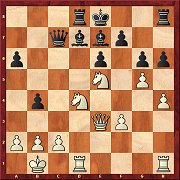
Kosintseva,T - Dembo,Y
Position after 21...g6
| In addition, other participants have annotated selected games on the DVD. There is the particularly interesting duel between Tatiana Kosintseva and Yelena Dembo. Both players have annotated one of the games from their match. "What a game..." is Yelena Dembo’s closing remark on the first game. She had Black and in a Richter-Rauser Variation she came under violent pressure. Her criticism of her own treatment of the opening is appropriately clear. In the position on the board she invited her opponent to smash open her king position after her own faulty 21...g6. But Kosintseva not only scorned the deadly 22.h5, but a few moves later even liquidated to a lost ending with a knight against a bishop. |

Kosintseva analysiert
Dembo,Y - Kosintseva,T
| Tatiana Kosintseva refers to the less than optimal course of that game in her analysis of the second game. Since she had to play for a win with Black, she aimed to reach as complicated play as possible in a Scheveningen Variation. And she managed it. Dembo made a serious mistake with 15.Nd1 and afterwards had to suffer the demolition of her queenside. But for her part Kosintseva neglected to worry about the safety of her own king in time and so an open tactical battle flared up at the end of which Dembo managed to save the game and progress to the next round with a perpetual check. |
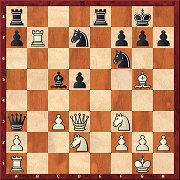
Zuriel,M - Muzychuk,A
Position before 15...Bxf2+
| Junior World Champion of 2010, Anna Muzychuk, like Yelena Dembo, was also eliminated in round 3 by one of the mighty Chinese players. For this issue of ChessBase Magazine she has commented on one of her first round victories over the clearly lower rated Argentinian player Marisa Zuriel. In the Sicilian Alapin Variation the Slovenian player quickly got good play and in the position on the board let herself be tempted to take on f2. Things turned out well thanks to an inaccurate continuation chosen by her opponent and Muzychuk was an exchange up at the end of the complications. But as she explains in her analysis, the game could have continued in a most unclear fashion after 16.Kxf2 Nc5 17.Qb1 and then e.g. 17...Nfe4 18.Nxe4 dxe4 19. Rb3. |
| 08.12.-15.12.2010 
Last minute victory
Magnus Carlsen
| London Chess Classic Four absolutely world class players and the four best from England. In addition a very strong subsidiary programme with daily live commentary by GM Daniel King, GM Chris Ward, GM Stephen Gordon etc. Star appearances by Garry Kasparov and Viktor Korchnoi and so on and so on... That was for the second London Chess Classic the entertaining and completely successful plan of the organisers. And even the players themselves did their part in ensuring success as they did their post-mortem analysis of their games in front of the public and the cameras. On this DVD you will find, in addition to analysis by the stars such as Magnus Carlsen, Vishy Anand and Luke McShane, excerpts from the live streams from London with a toal running time of more than 6 hours! |

Best English player
Luke McShane | The biggest surprise in London was provided by the one time shooting star of England, Luke McShane. The previous youth world champion seems to have rejoined the ranks of the professionals and just before London won the strong "Remco Heite" tournament in Wolvega in the Netherlands. In London he also started fast and furiously and in the first two rounds had defeated Magnus Carlsen and Nigel Short. On the DVD McShane analyses his opening victory over Carlsen and also his fortunate last-round draw with David Howell. |

McShane,L - Carlsen,M
Position after 18.Nc6
| The opening game against Carlsen began with what was at first sight a quiet opening (Symmetrical English with mutual fianchettoed king’s bishops), but right on move 9 Carlsen made it clear that he was out for complicated play. McShane, who was obviously very well prepared for his opening, gave up the bishop pair early on and in return received a lead in the opening and palpable pressure on the queenside. So as not to let his opponent develop, McShane immediately went over to a queenside advance and with the spectacular 18.Nc6 (diagram) set in motion a splendid parade by his knight. It cannot be captured in the position on the board, because Black loses a pawn after 18...bxc6 19.bxc6 Qc7 20.cxd7 or his queen after 19...Qxc6 20.Nf6+. The English player followed another four knight moves with a no less impressive knight sacrifice: 22. This time Carlsen had to accept it, though with devastating consequences. Play through the game with McShane’s comments and enjoy his victory. |
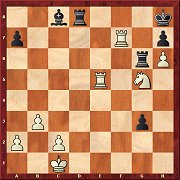
Howell,D - McShane,L
Position before 38.Rd5
| After a second-round victory over Nigel Short McShane was able to draw all his subsequent games up until the final round. There the following situation arose: because of the 3-point rule in force in London (3 points for a victory, 1 point for a draw) he was sharing the lead with Carlsen and Anand. In view of the prospect of a possible tournament victory McShane decided in his final-round game with David Howell to go all-out and chose, as in his game against Short, the Dragon Variation. In the middlegame Howell managed, thanks to clever knight manoeuvre and a timely exchange of queens to achieve an advantage, but McShane seized the initiative in a tactical melee in mutual time trouble. As a result, both sides missed winning chances and in the final position (diagram) Howell, in view of the few seconds left on his clock, contented himself with a draw by repetition of the position after 38.Rd5. Can you find the win for White? If not let McShane show you it. |

Carlsen,M - Nakamura,H
Position after 46.Qe4
| The result of this game, combined with Anand’s draw with Kramnik, cleared the way another victory by a nose for Magnus Carlsen. After a poor start with defeats in rounds one and three, he had to really get stuck in. His fourth game, against Nakamura, marks the turning point. On the DVD you will find this game annotated by Carlsen himself from the very first opening moves (English Opening with 1.c4 f5 2.g3 Nf6) all the way to the bishop ending. After an exhausting positional struggle the Norwegian first won a pawn and then in the position in the diagram decided the game in his favour with 46.Qe4. because the subsequent bishop ending is a simple win for White thanks to a little trick (53.Bd5! - Carlsen had of course worked this out). Click on the link under the diagram and play through the game with the comments of the tournament winner who is once again at the top of the world ranking list. |

Anand analyses
Anand - Carlsen
| World Champion Vishy Anand has annotated his third round win against Carlsen for this issue and for the first time made use of the Chess Media audio format. His 13-minute analysis is one of the absolute high points of this DVD and presents for example some tactical fireworks. Should you not be able to keep up with the Indian, then make use of the “Pause” key and quietly go through the variations on the board. Anand’s explanations about the opening are also remarkable, when one considers that he, and it can happen to a world champion, played a move which actually belonged in a variation he had calculated earlier. And 20.Nxc4 was also a mistake by Anand – which nevertheless led to a very entertaining game. After a bad decision by Carlsen, Anand got considerable pressure on the black king position despite the reduced material and in the endgame he was able, in spite of the missed chances in the middlegame, to decide matters in his favour. Here is a selection of live streams from the London Tournament:
Round 1 Adams - Howell
Round 1 McShane - Carlsen Part 1 Round 1 McShane - Carlsen Part 2
Round 1 Short - Kramnik
Round 2 Carlsen - Adams
Round 2 Short - McShane
Round 3 Adams - Short
Round 4 Carlsen - Nakamura
Round 4 Kramnik - Howell
Round 4 McShane - Adams
Round 4 Short - Anand
Round 5 Adams - Kramnik
Round 5 Anand - McShane
Round 5 Nakamura - Short
Round 6 Adams - Anand
Round 6 Korchnoi analyses
Round 6 Short analyses and Short - Howell
Round 7 Anand - Kramnik and Anand analyses further
Round 7 Howell - McShane |
| 11.12.-22.12.2010 
Sergey Karjakin
| Russian Super Final On his very first appearance in the Russian Superfinal ex-Ukrainian Sergey Karjakin was well on the way to winning the title. With four victories and six draws, Sergey Karjakin had shown the most stable performance before the final round and had half a point of a lead over the. For example, the former child prodigy had beaten a rival for the title in Ian Nepomniachtchi. A draw in the final round would have sufficed to give Karjakin the title. But just at that point there was a “blip” and he lost to Malakhov. A play-off against Nepomniachtchi had to decide, and at the very last moment Karjakin lost out in the so-called "Armageddon" game. But at least he had amongst his wins one against the victor in the tournament. Dorian Rogozenco has already described the decisive moments of the game Karjakin - Nepomniachtchi in his first introductory video. Here you can play through the whole game with Karjakin’s analysis. |

Tactics column
How can White exploit the unusual position of the black king here?
| From the opening trap to the endgame study Training in ChessBase Magazine begins with the very first moves and takes in all the phases of a game of chess. The 13 up-to-date Openings articles with numerous ideas and suggestions for your repertoire can be found here or above amongst the links. Rainer Knaak’s opening trap (including its Fritztrainer video) contains a relatively simple example this time. Cick here to reach the column. The openings articles of Leonid Kritz (French Steinitz Variation), Valeri Lilov (Dutch) and Adrian Mikhalchishin (Grünfeld Defence and also Ruy Lopez) have also been produced in video format. You will find these videos and other clips in Chess Media format in the column Fritztrainer. Peter Wells’ subject in his Strategy column is called: "The anatomy of a key pawn advance (e5-e6) Part 2". In Daniel King’s long-running favourite Move by Move he deals with a game in the King’s Indian. And in the columns for Tactics (see diagram) and Endgames Oliver Reeh and Karsten Müller have once more selected for you all that is best in the latest tournament practice. |
 | Opening Surveys Bauer: Scandinavian B01 1.e4 d5 2.exd5 Qxd5 3.Nc3 Qa5 4.d4 Nf6 5.Nf3 Bg4 
| | 5...c6 is usually played in the mainline Scandinavian, but Christian Bauer is an expert in the development of the bishop to g4 and believes that this continuation is playable despite its bad reputation. |
Marin: Caro-Kann B15 1.e4 c6 2.d4 d5 3.Nc3 g6 4.e5  | | In this hybrid of the Caro-Kann and Pirc Defence, if White plays 4.e5 he usually follows up with f4. The best setup for Black then consists of, where possible, doing without ...Bg7 and playing instead ...f6, ...Nh6 and ...Bg4. |
Bojkov: Sicilian B32 1.e4 c5 2.Nf3 Nc6 3.d4 cxd4 4.Nxd4 d5 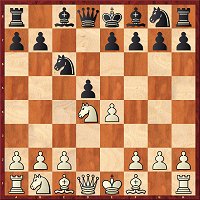
| | According to the analysis of Dejan Bojkov, the move 4...d5 is good for more than just a surprise. But there are hardly any variations in which White gets an advantage. It mostly comes down to an ending with White having a queenside superiority but in which Black has a strong centre. |
Grivas: Sicilian B33 1.e4 c5 2.Nf3 Nc6 3.d4 cxd4 4.Nxd4 Qb6 5.Nb3 Nf6 
| | The Eros Variation brings together lines in which White does without 6.Nc3: there are the rather dubious pawn sacrifice 6.Be3 and the more interesting 6.Bd3. But nowhere does Black have serious problems and so 6.Nc3 must be a better choice. |
Dembo: Sicilian B66 1.e4 c5 2.Nf3 Nc6 3.d4 cxd4 4.Nxd4 Nf6 5.Nc3 d6 6.Bg5 e6 7.Qd2 a6 8.0-0-0 Bd7 9.f3 h6 10.Be3 b5 
| | The author has a lot of experience with this variation and had good success with it in the Women's WCh in Antakya. This article gives deep insights into a demanding variation of the Sicilian Defence. |
Moskalenko: French C02 1.e4 e6 2.d4 d5 3.e5 c5 4.c3 Nc6 5.Nf3 Qb6 6.Bd3 
| | After 6.Bd3, accepting the gambit with 6...cxd4 7.cxd4 Bd7 8.0-0 Nxd4 is considered quite good for Black. But one is never safe from surprises and having a second ace up one’s sleeve can do no harm; for that reason Moskalenko also analyses 6...Nh6 7.0-0 cxd4 8.cxd4 Nf5. |
Kritz: Ruy Lopez C72-C74 1.e4 e5 2.Nf3 Nc6 3.Bb5 a6 4.Ba4 d6 
| | For the author it is clear that the only chances for an advantage for White in the Modern Steinitz Variation lie in 5.0-0. The main subject for his article is then 5...Bg4 6.h3 h5, and finally he manages to demonstrate a slight superiority for White. |
Schandorff: Semi-Slav D43 1.d4 d5 2.c4 c6 3.Nf3 Nf6 4.Nc3 e6 5.Bg5 h6 6.Bxf6 Qxf6 7.e3 Nd7 8.Bd3 g6 9.0-0 Bg7 10.e4 dxc4 11.e5 Qe7 12.Bxc4 0-0 
| | If Black captures on c4 too soon, this has disadvantages (shown in CBM 139). But even a later capture on c4 can be exploited by White: with the intermediate move 11.e5. Schandorff examines whether this really brings an advantage. |
Hazai/Lukacs: Semi-Slav D43 1.d4 d5 2.c4 c6 3.Nf3 Nf6 4.Nc3 e6 5.Bg5 h6 6.Bxf6 Qxf6 7.a3 
| | In the Ubilava Variation with 7.a3 White would like to play e2-e4 without being disrupted by a check on b4. But Black can exploit the loss of a tempo – best of all with 7...dxc4. After 8.Ne5 probably the old move 8...c5! is still the best. |
Skembris: Queen's Indian E15 1.d4 Nf6 2.c4 e6 3.Nf3 b6 4.g3 Ba6 5.Qa4 c5 6.Bg2 Bb7 7.dxc5 bxc5 8.0-0 Be7 9.Nc3 0-0 10.Rd1 Qb6 11.Bf4 
| | After the popular 5.Qa4 it frequently comes down to the position in the diagram (unless Black plays 7...Bxc5). There have been a lot of games at the top level and theory is still in flux. Skembris has had his own practical experience with the variation. |
Postny: Nimzoindian E20 1.d4 Nf6 2.c4 e6 3.Nc3 Bb4 4.Nf3 c5 5.g3 cxd4 6.Nxd4 Ne4 7.Qd3 Nxc3 8.bxc3 Be7 
| | If this variation is playable for Black, and that is what Postny’s analyses say, then one has not only a good setup against 4.Nf3, but also one against certain lines of the Catalan and the Symmetrical English Variation. |
Kuzmin: Nimzoindian E46 1.d4 Nf6 2.c4 e6 3.Nc3 Bb4 4.e3 0-0 5.Nge2 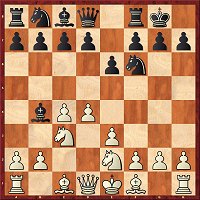
| | Although the player after whom the Rubinstein Variation 4.e3 is named always continued with Nge2, the move Nf3 became much more popular. Kuzmin’s article presents a few modern developments in the Nimzo-Indian with 5.Nge2 (to be continued in CBM 141). |
Schipkov: King's Indian E80 1.d4 Nf6 2.c4 g6 3.Nc3 Bg7 4.e4 d6 5.f3 c6 6.Be3 a6 
| | Schipkov shows several lines against the setup with ...c6 and ...a6 which should give White an advantage. As well as the traditional continuation 7.Bd3 both 7.c5 and even 7.g4 should bring Black some problems. |
|
|







































